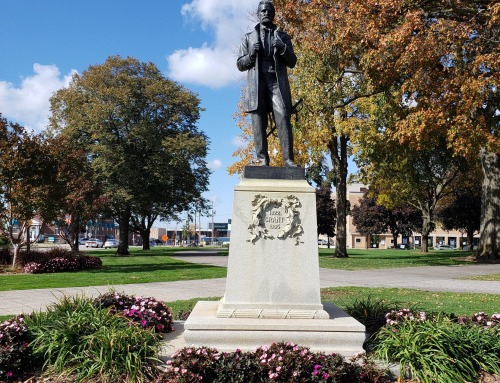Magdelaine Laframboise was a woman ahead of her time. She was born in 1780, when women were expected to stay home and care for the children, cook, clean and do various other chores, while the husband was considered the head of the household and in charge of the money. So how was a woman to survive when her husband was killed? It was no problem for Magdelaine, who simply took control of her situation and became one of the most successful fur traders in the Northwest Territory of the United States. That achievement would be impressive for anyone, much less a widow. This being the month of her birth, let’s learn more about the First Lady of Mackinac Island.
Magdelaine Laframboise was born Marguerite-Magdelaine Marcot in February of 1780, near Fort St. Joseph. Her father, Jean Baptiste Marcot, was a French agent for the Northwest Fur Company, who helped move Fort Michilimackinac from the mainland to the island.
Magdelaine’s mother, Marie Nekesh, was born into the Odawa tribe where her father was Chief Kewinoquot. Jean Baptiste and Marie had six children before Magdeleine was born and sadly when she was three, her father was killed by Indians at the portage between the Fox and Wisconsin rivers. Marie moved from Fort St. Joseph to Mackinac after the American Revolution, taking Terese and Magdelaine with her. The girls were baptized August 1, 1786 on Mackinac Island by a visiting priest.
A few years later, they moved back down to the village of Lac Courtes Oreilles at the mouth of the Grand River, now known as Grand Haven. The Grand River was an important part of the trading route into the interior of Michigan at this time. The older children had been sent to Montreal to be educated in the French-language schools, but Marie didn’t have the money to send Terese and Magdelaine to school as well. The two sisters were raised in the Odawa culture, and both became fluent in four languages: Odawa, French, English, and Chippewa.
In 1794, fourteen-year-old Magdelaine married Joseph La Framboise. Joseph was older, aged twenty-nine, and was a successful fur trader. He had started trading along the Grand River in 1783 and had many connections in the trade business. The couple was first married only by Odawa custom, after which Magdelaine joined her husband in his business. The importance of the fur trade in Michigan cannot be denied, as the furs were needed back east for fashionable hats and coats. The couple was able to benefit from a lower value of fur in the rural areas and a lower value of trade goods in the city.
They had other partners too, one notably Charles Langlade. Magdelaine’s sisters were also involved in the fur trading business. Terese married George Schindler and an older sister, Catherine, married Jean Baptiste Cadotte. Terese was based mostly on Mackinac Island.
Joseph and Magdelaine quickly built a successful fur trade, centered on the Grand River, though Joseph had connections in Montreal and Milwaukee. They established over 20 trading posts in the Grand River Valley of western Michigan. In the fall, they would take their trade goods to barter with the Odawa from Mackinac Island down to the Grand River area, especially the areas that are now Lowell and Ada. Every spring they would return to Mackinac Island with the furs they had acquired in lower Michigan. This was a very good area for the couple to work. The Flat River was the richest furring river at the time and there was a large Odawa population to trade with. In 1796, Joseph built a cabin in Lowell and another cabin on the shores of Duck Lake that overlooked Lake Michigan.
On September 24, 1795, they had a daughter, Josette, yet it wasn’t until July 11, 1804, that the marriage between Magdelaine and Joseph was solemnized by a Catholic missionary at Michilimackinac. This meant the marriage was celebrated with the religious rites of the Catholic Church, a common practice at the time, as Catholic priests often traveled throughout the frontier since many settlements did not have a permanent priest. Their son Joseph was born in March of 1805. Magdelaine was eventually able to send both Josette and Joseph to school in Montreal to be educated in the French schools there.
In 1806, the family was traveling to their Lowell trading post. They stopped at what is now Grand Haven and, while praying, Joseph was murdered by a disgruntled native. His murderer was brought to Magdelaine for restitution, but since she was a deeply religious woman and a devout Catholic, she simply forgave him. It is unknown what happened to the man after that.
Following Joseph’s murder, Magdelaine took over her husband’s business, becoming the first recorded businesswoman in Michigan. She obtained her traders license, managed several trading posts and expanded the business throughout the western and northern parts of the Upper Peninsula. At the time, a successful and experienced fur trader would earn about $1,000 per year. Magdelaine was so successful, she earned $5,000 to $10,000 per year.
On April 2, 1816, Magdelaine’s daughter, Josette married Benjamin K. Pierce, the American commandant of Fort Mackinac. Magdelaine was away from the island at the time of the civil wedding, but when she returned, they had a ceremony and party to celebrate the union.
Magdelaine continued to be successful in the early 1800s, and did much of her business on Mackinac Island. She had multiple contacts in the fur trader world and communicated well with many people from different walks of life thanks to her ability to speak several languages. She was especially well-known and respected by the indigenous people. At this time, John Jacob Astor dominated the fur trade with his American Fur Company. Magdelaine was able to compete with the famous businessman, but in 1818, she joined that company.
That same year Magdelaine became a grandmother, when Josette and Benjamin had their first child, a daughter named Josette Harriet. Two years later, on November 24, 1820, Josette gave birth to Benjamin Langdon Pierce, but tragically died from complications during the birth. Baby Benjamin died a few days later. Magdelaine took over the care of two-year-old Josette, whom she called Harriet.
Magdelaine continued to work with Astor, and they worked well together, but in 1822 she decided to retire at the age of 41. She sold her Mackinac side of the business to Astor and the American Fur Company, and she sold her Grand River trading post to Rix Robinson, a Michigan pioneer.
Magdelaine remained on Mackinac Island, a very wealthy woman, but she was not through growing, helping others and making a difference. She learned to read and write in both French and English and after her son in law, Captain Pierce, oversaw the construction of a stately home. She started the first Catholic school for Native children on Mackinac Island in that house. She was extremely involved in Ste. Anne’s Catholic Church on the island and taught catechism to the parish’s children. She kept the congregation together when it did not have a regular priest and paid the salaries of visiting priests. She took in many children and hired other teachers to train and indoctrinate them. The Ste. Anne’s parish register lists Magdelaine as the godmother at many baptisms and the witness of many marriages.
Around 1827, Magdelaine’s son, Joseph, married Magdeleine ‘Sleepy Eyes’ Sisseton. He had been working as a fur trader and merchant like his parents and lived along the Minnesota River Valley. He also spent much time in Montreal, where Magdeleine would often travel to visit him. The couple had one son, Frances. Also in 1827, Ste. Anne’s church leaders decided to move the church from its original location. Magdelaine donated property next to her home as a building site. This is where Ste. Anne’s church stands today. Her only request was that she be buried beneath the altar of Ste. Anne’s after her death.
During the 1830s and 1840s, Magdelaine continued to host visitors to the island, most notably the French writer and diplomat Alexis de Tocqueville. De Tocqueville came to America in 1831 to explore and write about the new country. She also hosted Sarah Margaret Fuller, an American writer from Massachusetts. Fuller wrote a non-fiction book on her trip to the frontier called Summer on the Lakes. She wrote favorably about Magdelaine, calling her “very ladylike,” “a great character,” and a “shrewd woman of business.” Fuller also reported that many islanders came to her for help or advice.
Magdelaine never remarried, instead busying herself with her granddaughter and the needs of others on the island. She died at the age of 66 on April 4, 1846 in her home. Fr. Henri Van Renterghen of Ste. Anne’s church had her interred beneath the altar of the church, as Magdelaine had asked years before. In the 1860s, Ste. Anne’s church was renovated and a basement activity center was added. As a result, the remains of Magdalaine were relocated to Ste. Anne’s churchyard.
Magdelaine LaFramboise’s successes would be notable if she were a man, but the fact that she was a woman and was still able to achieve what she did makes it all the more impressive. She had many heartaches in her life, but her strength and faith allowed her to use these tragedies and turn them into triumphs. She left a lasting impression on all those she met, especially those on her beloved Mackinac Island. Her contributions were finally acknowledged when she was elected into the Michigan Women’s Hall of Fame in 1984. A woman ahead of her times over 200 years ago, can you imagine what she would have accomplished today!







Leave A Comment
You must be logged in to post a comment.